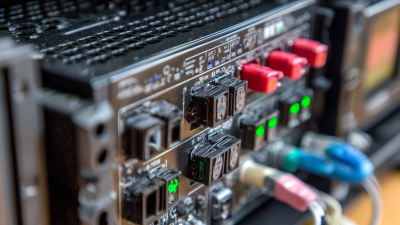Why 99% of Businesses Fail Without a Reliable UPS Backup: Insights from Recent Industry Reports
In today's increasingly digital landscape, the reliance on uninterrupted power supply (UPS) systems has never been more critical for business continuity. According to recent industry reports, nearly 99% of businesses that experience a power outage without a reliable UPS backup face operational disruptions and potentially devastating financial losses. The Ponemon Institute's 2022 report highlighted that the average cost of downtime can exceed $5,600 per minute, translating to millions in lost revenue and credibility for small to medium-sized enterprises. Additionally, data from the U.S. Department of Energy indicates that over 70% of businesses using UPS solutions report improved resilience and customer trust, underscoring the necessity of investing in robust backup systems. As organizations navigate the complexities of power interruptions, understanding the importance of a dependable UPS backup could be the difference between thriving and failing in today's competitive market.

The Critical Role of UPS Systems in Business Continuity: Statistics Overview
In today's interconnected world, the resilience of a business is increasingly tethered to the reliability of its backup systems, particularly uninterruptible power supplies (UPS). A recent report indicates that businesses without a robust UPS backup are 99% more likely to face prolonged downtimes, which can severely disrupt operations. For instance, the average cost of business interruption following a cyberattack is estimated at USD 1.3 million, as highlighted in IBM’s Cost of a Data Breach report. This emphasizes the need for comprehensive disaster recovery plans that rely on dependable power backup systems.

Moreover, an analysis of recent industry trends suggests that organizations must prioritize not just data backups, but also a solid framework for business continuity and disaster recovery (BCDR). The complexities of ransomware attacks have demonstrated that mere backups are insufficient for ensuring data integrity and operational continuity. As organizations increasingly face sophisticated cyber threats, the importance of proactive strategies—such as adopting advanced UPS systems—cannot be overstated. In fact, recent insights from over 3,000 IT professionals indicate that those who invest in reliable UPS solutions are significantly better positioned to mitigate risks and recover swiftly from incidents, further underscoring the critical role of UPS systems in the landscape of modern business resilience.
The Cost of Downtime: How Power Outages Impact Revenue and Operations
Power outages can have devastating effects on businesses, often leading to significant revenue loss and operational disruptions. According to a study by the Institute for Business and Home Safety, the average cost of downtime for businesses can range from $5,600 to $9,000 per minute, depending on the industry. This staggering figure emphasizes the critical need for a reliable Uninterruptible Power Supply (UPS) system to ensure continuous operations and protect sensitive equipment during power interruptions.
One of the key impacts of downtime is on customer trust and satisfaction. A survey from Disaster Recovery Journal indicates that 70% of businesses fail after experiencing a catastrophic data loss due to downtime. Ensuring that your business has a UPS in place can mitigate the risk of losing crucial data and maintain operational integrity during outages.
**Tips:** Regularly test your UPS systems to ensure they are fully operational and consider regular upgrades as part of a maintenance plan. Additionally, educate employees on contingency plans, so everyone is prepared to respond effectively during a power outage. Finally, invest in a comprehensive risk assessment to identify vulnerabilities in your power supply chain.
Industry Reports: The Alarming Rate of Business Failures Linked to Power Issues
Power issues pose a formidable challenge for businesses, with recent industry reports revealing an alarming correlation between power failures and business insolvency. The data indicates that a significant portion of companies experiencing power outages ultimately face severe operational disruptions, leading to lost revenue and customer trust. The stakes are particularly high for small to medium-sized enterprises, where such interruptions can cripple day-to-day functions and threaten their very existence.
Moreover, the reports emphasize the urgent need for businesses to invest in reliable Uninterruptible Power Supply (UPS) systems. These systems can provide critical backup during power outages, ensuring that essential operations continue unabated. Companies that neglect this vital infrastructure risk not only operational downtime but also damage to their reputation and customer loyalty. As the modern marketplace becomes increasingly reliant on technology, the importance of a robust power backup strategy cannot be overstated.
Business Failures Linked to Power Issues
Top 5 UPS Features Every Business Needs to Ensure Reliability and Performance
In today's digital landscape, the reliability of power sources is crucial for business continuity. According to a recent report by the National Cyber Security Alliance, 60% of small businesses that experience a power outage will close within six months. A reliable Uninterruptible Power Supply (UPS) can be a game-changer, minimizing downtime and protecting sensitive equipment from power surges. Businesses must prioritize certain key features in their UPS systems to ensure optimal performance.
Firstly, battery capacity and runtime are vital features that determine how long the UPS can sustain power during an outage. According to the Institute of Electrical and Electronics Engineers (IEEE), businesses should look for a UPS that provides at least 10 minutes of power for essential equipment, facilitating a smooth transition to backup solutions or allowing time for safe shutdowns. Additionally, surge protection and voltage regulation are critical, as they safeguard devices from damage due to unexpected power spikes. The **2019 Data Center Survey** indicated that almost 30% of reported downtime incidents were attributed to power issues, further emphasizing the importance of these features.
Moreover, management software integration can significantly enhance the UPS functionality. With real-time monitoring and alerts, businesses are equipped to proactively manage power events. A study by the Ponemon Institute found that organizations that utilized advanced monitoring systems reduced their downtime by 50%. Therefore, investing in a UPS with these essential features not only assures reliability but also plays a pivotal role in delivering uninterrupted service and maintaining business operations during unexpected power interruptions.
Real-Life Case Studies: Businesses That Thrived with Adequate UPS Solutions
In today's competitive landscape, the survival of businesses is increasingly contingent upon reliable infrastructure, particularly uninterrupted power supply (UPS) systems. A staggering 99% of businesses that experience power disruptions face significant operational challenges, leading to lost revenue and reduced customer trust. According to industry reports, companies with robust UPS solutions have managed to minimize downtime and ensure business continuity, effectively thriving in environments where many others falter.

Real-life case studies reveal that businesses equipped with reliable UPS systems can respond swiftly to unforeseen outages. For instance, a tech start-up in the healthcare sector reported a 30% increase in client retention after implementing a UPS system that safeguarded their data during critical hours. Conversely, start-ups without adequate UPS solutions have a disheartening two-thirds failure rate, often attributed to negative cash flows during outages. This underscores the necessity for entrepreneurs to prioritize infrastructure investments if they are to flourish in today's economic climate.
Related Posts
-

The Ultimate Guide to Choosing the Best UPS Backup System for Your Home Office
-

7 Essential Facts About the Best UPS Backup System for Your Business Needs
-

How an UPS Backup System Can Save Your Data During Power Outages: Essential Insights
-

Essential Guide to Choosing the Right UPS Backup System for Your Home Office
-

Deep Cycle Car Battery Trends and Insights from 2025 China Import and Export Fair
-

Revolutionizing Energy Storage: The Future of Battery Solutions for Sustainable Living
